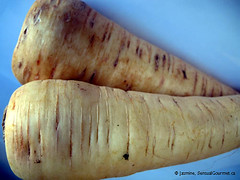 Parsnips (Pastinaca savita), elicit either love or a polite, yet patient smile. Boiled, mashed, fried or roasted, parsnips are versatile pale golden, carrot-like veggies that are winter staples.
Parsnips (Pastinaca savita), elicit either love or a polite, yet patient smile. Boiled, mashed, fried or roasted, parsnips are versatile pale golden, carrot-like veggies that are winter staples.History
Parsnips are native to western Asia and Europe and have been eaten there for more than 2000 years. Wild parsnips are small, woody and inedible, but perhaps because of their natural sweetness and parsnippy scent, they may have been used as a flavouring agent. Over years of cultivation, farmers tweaked them to be larger…and, well…edible.
The Roman Emperor Tiberius had them brought from the Rhine to Rome, where encouraged farmer to cultivate them. Unfortunately, it’s difficult to truly gauge how they were used in Classical cooking as Greek and Roman writers used the term “pastinaca” for both carrots and parsnips. As with many things of a certain form, Ancient Romans imbued them with aphrodisiac-like powers.
Mediaeval Europeans found two important uses for parsnips—they served double duty as a starch and a sweet substitute for the more expensive sugar and honey. Parsnips were preferred for their flavour, nourishment and were eaten with saltfish during Lent’s meatless fasting periods.
As sugar became readily available and less expensive, coupled with the potato’s introduction the parsnip’s popularity decreased. Apart from northern Europe and Great Britain, worldwide consumption is relatively small.
Etymology
The English word “Parsnip” can be traced to pastinaca, with the “nip” added to indicate that it was like a turnip.
Varieties
In Ontario, the principal commercial varieties are All-American, Hollow Crown Improved and Harris Model. They are all similar in size, taste and colour. The parsnip’s tough, wiry root, tapers from the crown to the root. Its tough and furrowed stem can grow from 30-60cm high with 20cm-long leaf-stalks; the leaves divided into several pairs of leaflets, each 2.5-5cm long and about 1.5-2 cm wide. Leaflets are fuzzy, especially on the underside.
Experiencing
Not everyone likes parsnip’s flavour and many have troubles pairing it with food (but it goes nicely with salty dishes such as ham or salt cod.). Its flavour is a sweet, nutty, spicy and sometimes peppery taste.
Parsnips do well with long cooking techniques such as casseroles, stews, or even oven-roasted on its own. The veg can also be microwaved, steamed or boiled. Classic preparations include mashed parsnips topped with buttered bread crumbs, glazed, creamed or in soups. The Dutch use them in soups, while the Irish make a type of beer with them.
Keeping
Select firm, moderately-sized veggies as large ones can be woody. Their surface should be relatively clean and free of surface blemishes. Avoid ones that are limp, shrivelled, or spotted. Store them, refrigerated, in a plastic bag for up to two weeks.
So…do you love them, hate them, or simply indifferent? If you want to declare your feelings towards this root, Dave Walker can help...yes, that Dave Walker.
cheers!
jasmine
tags:
add this page to del.icio.us

I love parsnip soup. I usually can only find it at French restaurants though. I wish more people would make stuff with parsnips.
ReplyDeleteI love them, but have to say I use them mainly for making chicken stock.
ReplyDeleteThere's a great Nigel Slater recipe that gives them an Indian twist. Cut into chunks. Boil briefly, then saute with olive oil and butter (he uses a lot, I use not so much), then add curry leaves, dried red peppers and crushed corriander - and salt and pepper. Then cook until it gets browned and a bit crsuty - kind of like hash browns. Very nice.
I used to HATE parsnips when I was a kid! My parents adored them (they still adore them) and always served put them into the Sunday roasting pan with the potatoes. I couldn't understand why they thought parsnips were good.
ReplyDeleteNow I can understand. Parsnips are wonderful. Especially roasted parsnips! Why oh why do I not remember to buy them?!
-Elizabeth
Hi there nice blog! I use parnsnips a lot I buy them every week I go shopping! Nice to see someone write about them :)
ReplyDeletevisit jeena's healthy recipe blog
I got turned on to parsnips when in London and continue to make roasted parsnips 'til this day during the holiday season. Good stuff. I wish more people would discover its loveliness.
ReplyDeleteYou won't believe this Jasmine but I recently ate parsnip ice cream at a posh restaurant in Chicago. It was served with a financier (a French almond meal cake). Without being told, no one would have guessed parsnip, and it was a lovely and subtle combination with the financier. I hope to make a financier in the next month or two. I ordered molds online but they were mini and looked more like chocolate molds...
ReplyDeleteAKR
http://treataweek.blogspot.com
Hello all
ReplyDeletePeabody--I've not had them in soup before--usually boiled or mashed...I'm coming up with an idea...
Diane--Nigel's recip sounds really wonderful.
Elizabeth--I hope this post served as a memory jog for you:)
BP--Unfortunately, parsnips have a bad rep...I think it's time we do a parsnippy event...
AKR--Welcome! I can't imagine what parsnip ice cream would taste like...I think I might have to experiment...
j